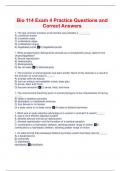Exam (elaborations)
Bio 114 Exam 4 Practice Questions and Correct Answers
- Course
- Institution
1. The last common ancestor of all animals was probably a ________. A) unicellular chytrid B) unicellular yeast C) multicellular algae D) multicellular fungus E) flagellated protist E) flagellated protist 1. What synapomorphy distinguishes animals as a monophyletic group, distinct from choanoflage...
[Show more]



